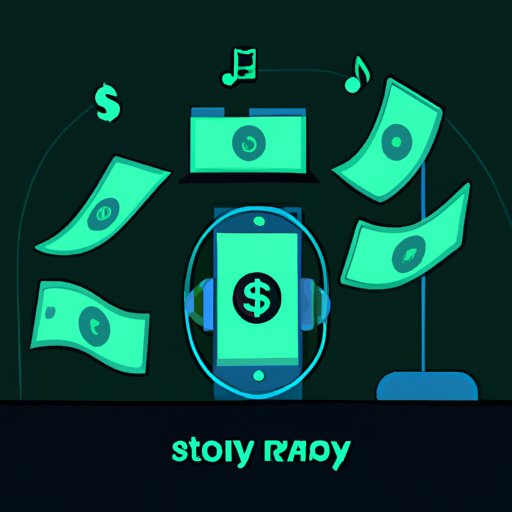Introduction
With the rise of digital music streaming, platforms such as Spotify have revolutionized the way we listen to music. Since its launch in 2008, Spotify has rapidly become one of the most popular streaming services today, with over 248 million active users worldwide.
However, as the music industry has shifted to a streaming-based model, questions have arisen regarding how much artists are actually paid for their work. In this article, we will explore Spotify’s artist payment system, analyze the pros and cons of their payment model, and discuss how to maximize your earnings as an artist on the platform.
Analyzing Spotify’s Artist Payment Model
When it comes to artist payments, Spotify operates on a “pay per stream” model. This means that when a user streams a song, the artist is paid a certain amount for each play. The amount that an artist receives per stream can vary greatly depending on a number of factors, including the artist’s record label, the country where the stream originates from, and the total number of streams.
Breaking Down Spotify’s Royalties System
Spotify pays out 70% of its revenue to rights holders, which includes both labels and publishers. The remaining 30% goes towards operating costs such as marketing, product development, and content acquisition.
The exact amount an artist receives per stream depends on a variety of factors, but typically ranges from $0.006 to $0.0084 per stream. For example, if a song is streamed 10,000 times, the artist would receive between $60 and $84. This may not seem like much, but when you consider the fact that some songs have been streamed millions of times, the earnings can add up quickly.
Exploring the Pros and Cons of Spotify’s Artist Payment System
While Spotify’s pay per stream model may seem unfair to some artists, there are several advantages to this system. Firstly, it provides artists with a steady source of income and allows them to track their earnings easily. Secondly, the system is simple and straightforward, making it easier for artists to understand how they are being compensated. Thirdly, because artists are paid per stream, they are incentivized to create and promote high-quality content that will attract more listeners.
On the other hand, there are also some drawbacks to Spotify’s artist payment system. Firstly, the amount of money an artist makes per stream is fairly small, and may not be enough to support a full-time career. Secondly, the system favors established artists who already have large fanbases, as they are more likely to get more streams. Lastly, because of the complexities of the music industry, some artists are not able to benefit from Spotify’s payment model due to contractual issues or other restrictions.
How Much Does an Artist Make on Spotify?
It is difficult to estimate exactly how much an artist can make on Spotify, as the amount varies greatly depending on the artist’s popularity, the streaming habits of their fans, and other factors. However, there are some general guidelines that can help artists gauge their potential earnings. Generally speaking, artists can expect to make around $1,000 to $5,000 per million streams, depending on their popularity.
An Overview of Spotify’s Royalty Structure for Artists
Spotify pays out its royalties to artists based on a complex formula. This formula takes into account several variables, including the artist’s popularity, the streaming habits of their fans, and the number of streams their songs have generated. All of these factors are then weighed against the total amount of money Spotify has earned in advertising and subscription fees.
How to Maximize Your Earnings as an Artist on Spotify
Although there is no surefire way to guarantee success on Spotify, there are some steps that artists can take to maximize their earnings. Firstly, artists should focus on creating and promoting high-quality content that will draw in new listeners. Additionally, artists should invest in marketing campaigns and collaborate with other artists to reach a wider audience. Finally, artists should take advantage of Spotify’s promotional tools such as playlisting and targeted ads. These strategies can help increase an artist’s visibility and boost their earnings.
Conclusion
In conclusion, Spotify’s pay per stream model provides artists with a reliable source of income while also incentivizing them to produce high-quality content. Although the exact amount an artist can earn on Spotify varies greatly, there are some general guidelines that can help artists gauge their potential earnings. Additionally, there are several strategies artists can employ to maximize their earnings, such as investing in marketing campaigns and collaborating with other artists.
Overall, Spotify’s artist payment system is complex and ever-evolving, but with the right strategies, artists can leverage the platform to generate a steady stream of income.
(Note: Is this article not meeting your expectations? Do you have knowledge or insights to share? Unlock new opportunities and expand your reach by joining our authors team. Click Registration to join us and share your expertise with our readers.)
